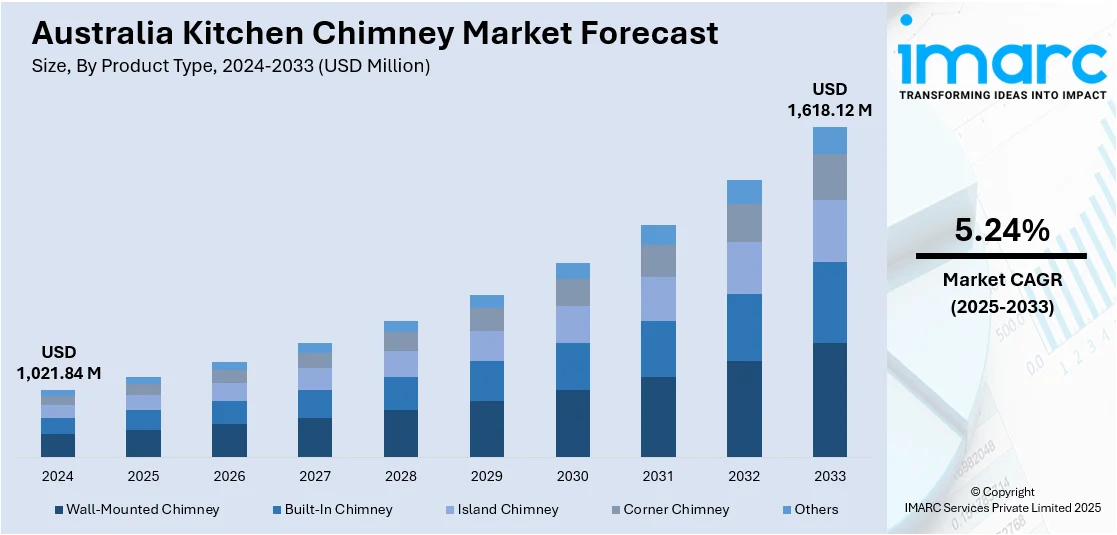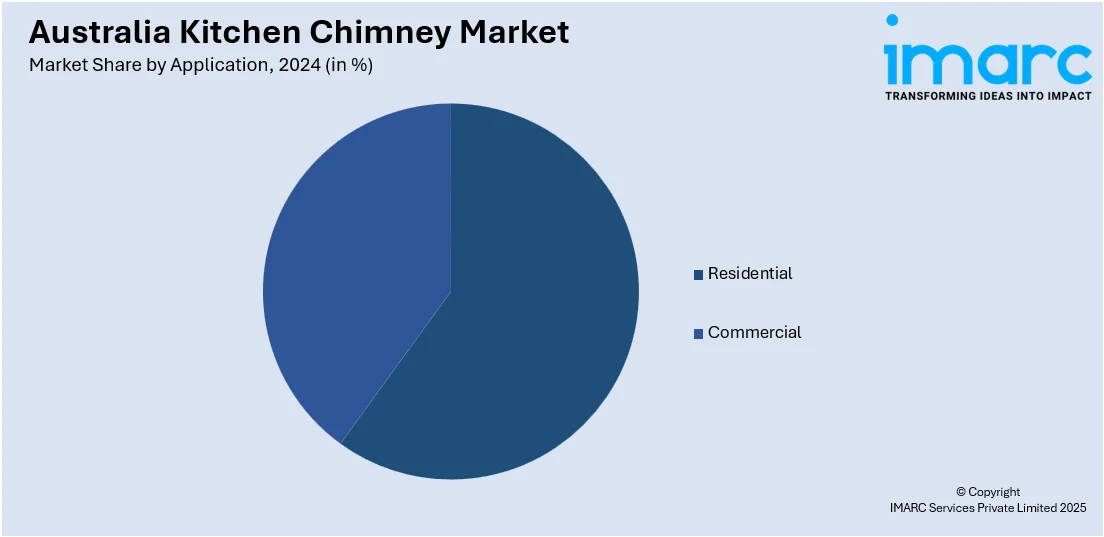
Australia Kitchen Chimney Market Size, Share, Trends and Forecast by Product Type, Duct Type, Application, Distribution Channel, and Region, 2025-2033
Australia Kitchen Chimney Market Overview:
The Australia kitchen chimney market size reached USD 1,021.84 Million in 2024. Looking forward, IMARC Group expects the market to reach USD 1,618.12 Million by 2033, exhibiting a growth rate (CAGR) of 5.24% during 2025-2033. The market is expanding due to the rising adoption of modern cooking appliances, combined with growing awareness regarding reducing indoor pollution. Technological advancements, such as introduction of energy-efficient models and smart features, and increasing disposable incomes are also contributing to the Australia kitchen chimney market share.
|
Report Attribute
|
Key Statistics
|
|---|---|
|
Base Year
|
2024
|
|
Forecast Years
|
2025-2033
|
|
Historical Years
|
2019-2024
|
| Market Size in 2024 | USD 1,021.84 Million |
| Market Forecast in 2033 | USD 1,618.12 Million |
| Market Growth Rate (2025-2033) | 5.24% |
Australia Kitchen Chimney Market Trends:
Growing Health Awareness
As Australia becomes more health conscious, consumers are paying more attention to ensuring that indoor air quality is good, especially in the kitchen. There are times when cooking results in smoke, grease, and odors that linger and have a negative impact on air quality and health. Kitchen chimneys are currently regarded as a necessary part of appliances that enhance ventilation and air circulation, allowing for the elimination of toxic fumes and pollutants. With increased emphasis on well-being, consumers are spending on high-tech chimney systems to design a healthier living space. This has generated increased demand for high-performance kitchen chimneys that provide improved filtration, smoke removal, and odor elimination, thus creating a cleaner and healthier kitchen environment. This trend is fueling business growth in the Australian kitchen chimney industry.

To get more information on this market, Request Sample
Technological Advancements
Technological innovations are having a significant impact on the Australian kitchen chimney market growth. New kitchen chimneys are available with smart options such as voice control, where users can control them without using their hands, increasing kitchen convenience. Auto-cleaning features have also been added, minimizing maintenance effort and extending the efficiency of chimneys for a longer duration. Energy efficiency is also a major concern, with most new models being made to save energy without compromising on performance. All these new developments not only enhance the user interface but also address the need for environmentally friendly and low-maintenance cooking appliances. As a result, the introduction of these smart, energy-efficient chimneys is significantly contributing to the Australia kitchen chimney market growth.
Increase in Modular Kitchens
The rise in modular kitchen designs in Australia has significantly contributed to the growing demand for integrated kitchen chimneys. Modular kitchens are designed for efficiency, organization, and aesthetics, often featuring built-in appliances and sleek, streamlined finishes. As these kitchens become increasingly popular, there is a higher demand for kitchen chimneys that seamlessly integrate into the design, offering both functionality and a visually appealing setup. Consumers are opting for built-in chimneys that match the modern look of modular kitchens, eliminating the need for bulky, freestanding units. This trend is driving innovation in chimney design, with manufacturers offering models that are both compact and powerful, catering to the aesthetic and performance needs of modern kitchen spaces. This shift is fueling the growth of the Australian kitchen chimney market.
Australia Kitchen Chimney Market Segmentation:
IMARC Group provides an analysis of the key trends in each segment of the market, along with forecasts at the country and regional levels for 2025-2033. Our report has categorized the market based on product type, duct type, application, and distribution channel.
Product Type Insights:
- Wall-Mounted Chimney
- Built-In Chimney
- Island Chimney
- Corner Chimney
- Others
The report has provided a detailed breakup and analysis of the market based on the product type. This includes wall-mounted chimney, built-in chimney, island chimney, corner chimney, and others.
Duct Type Insights:
- Ducted
- Ductless
A detailed breakup and analysis of the market based on the duct type have also been provided in the report. This includes ducted and ductless.
Application Insights:

- Residential
- Commercial
A detailed breakup and analysis of the market based on the application have also been provided in the report. This includes residential and commercial.
Distribution Channel Insights:
- Online
- Offline
A detailed breakup and analysis of the market based on the distribution channel have also been provided in the report. This includes online and offline.
Regional Insights:
- Australia Capital Territory & New South Wales
- Victoria & Tasmania
- Queensland
- Northern Territory & Southern Australia
- Western Australia
The report has also provided a comprehensive analysis of all the major regional markets, which include Australia Capital Territory & New South Wales, Victoria & Tasmania, Queensland, Northern Territory & Southern Australia, and Western Australia.
Competitive Landscape:
The market research report has also provided a comprehensive analysis of the competitive landscape. Competitive analysis such as market structure, key player positioning, top winning strategies, competitive dashboard, and company evaluation quadrant has been covered in the report. Also, detailed profiles of all major companies have been provided.
Australia Kitchen Chimney Market Report Coverage:
| Report Features | Details |
|---|---|
| Base Year of the Analysis | 2024 |
| Historical Period | 2019-2024 |
| Forecast Period | 2025-2033 |
| Units | Million USD |
| Scope of the Report |
Exploration of Historical Trends and Market Outlook, Industry Catalysts and Challenges, Segment-Wise Historical and Future Market Assessment:
|
| Product Types Covered | Wall-Mounted Chimney, Built-In Chimney, Island Chimney, Corner Chimney, Others |
| Duct Types Covered | Ducted, Ductless |
| Applications Covered | Residential, Commercial |
| Distribution Channels Covered | Online, Offline |
| Regions Covered | Australia Capital Territory & New South Wales, Victoria & Tasmania, Queensland, Northern Territory & Southern Australia, Western Australia |
| Customization Scope | 10% Free Customization |
| Post-Sale Analyst Support | 10-12 Weeks |
| Delivery Format | PDF and Excel through Email (We can also provide the editable version of the report in PPT/Word format on special request) |
Key Questions Answered in This Report:
- How has the Australia kitchen chimney market performed so far and how will it perform in the coming years?
- What is the breakup of the Australia kitchen chimney market on the basis of product type?
- What is the breakup of the Australia kitchen chimney market on the basis of duct type?
- What is the breakup of the Australia kitchen chimney market on the basis of application?
- What is the breakup of the Australia kitchen chimney market on the basis of distribution channel?
- What is the breakup of the Australia kitchen chimney market on the basis of region?
- What are the various stages in the value chain of the Australia kitchen chimney market?
- What are the key driving factors and challenges in the Australia kitchen chimney market?
- What is the structure of the Australia kitchen chimney market and who are the key players?
- What is the degree of competition in the Australia kitchen chimney market?
Key Benefits for Stakeholders:
- IMARC’s industry report offers a comprehensive quantitative analysis of various market segments, historical and current market trends, market forecasts, and dynamics of the Australia kitchen chimney market from 2019-2033.
- The research report provides the latest information on the market drivers, challenges, and opportunities in the Australia kitchen chimney market.
- Porter's five forces analysis assist stakeholders in assessing the impact of new entrants, competitive rivalry, supplier power, buyer power, and the threat of substitution. It helps stakeholders to analyze the level of competition within the Australia kitchen chimney industry and its attractiveness.
- Competitive landscape allows stakeholders to understand their competitive environment and provides an insight into the current positions of key players in the market.
Need more help?
- Speak to our experienced analysts for insights on the current market scenarios.
- Include additional segments and countries to customize the report as per your requirement.
- Gain an unparalleled competitive advantage in your domain by understanding how to utilize the report and positively impacting your operations and revenue.
- For further assistance, please connect with our analysts.
 Request Customization
Request Customization
 Speak to an Analyst
Speak to an Analyst
 Request Brochure
Request Brochure
 Inquire Before Buying
Inquire Before Buying




.webp)




.webp)












